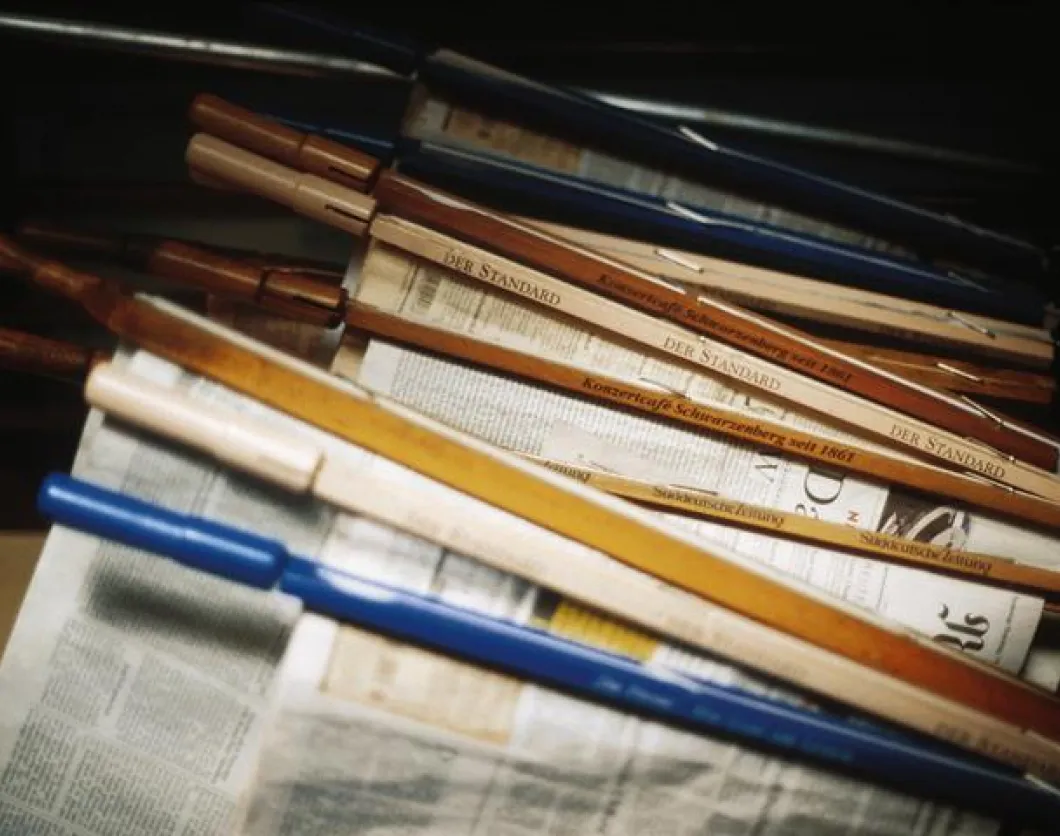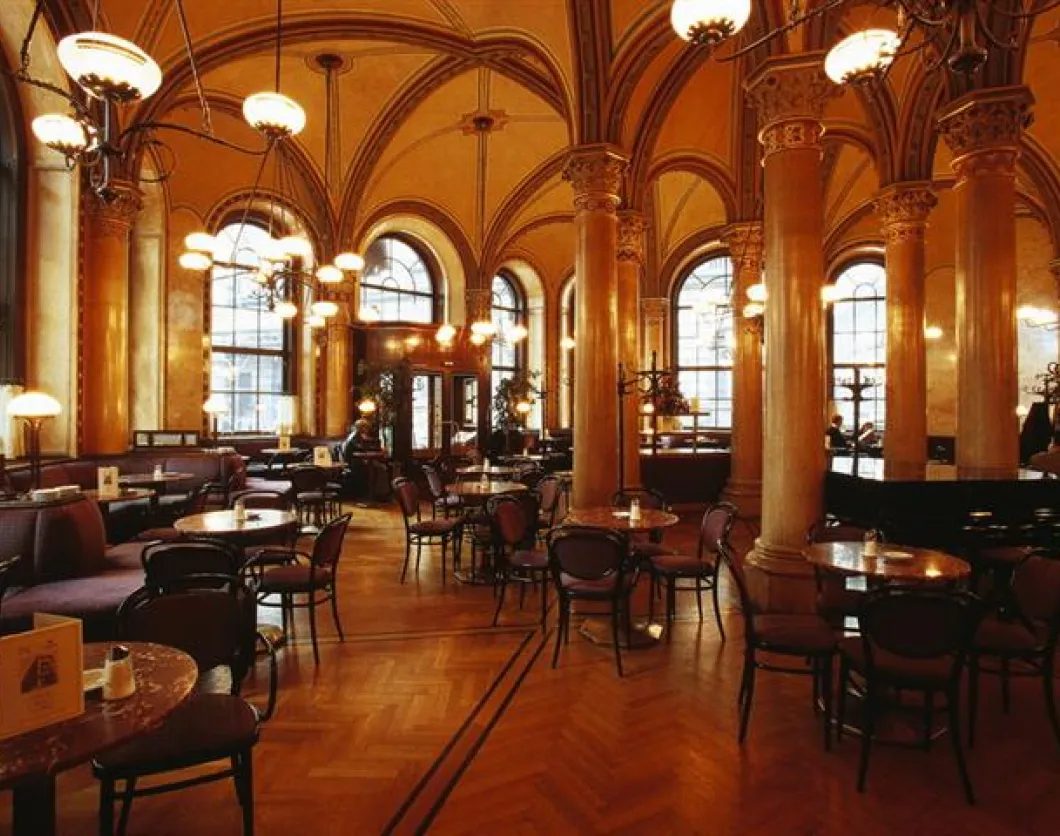Vienna in 1900 was a shimmering fabric composed of contradictions – such as “Dream and Reality” and “Death and Eros” – and some of the most prominent names in the history of European culture. The creative literary, artistic, architectural and musical talent concentrated in the city at the turn of the 20th century was unmatched. At that time, painters, musicians, architects, poets, journalists and other intellectuals met in Café Griensteidl, Café Central or Café Museum.
Café Griensteidl
The atmosphere in the “old” Griensteidl was legendary. For 50 intensive years, from 1847 to 1897, the “old” Griensteidl café was Vienna’s most famous cultural “institution”. There was hardly a writer, actor, critic, architect or musician of note in this fin-de-siècle world who did not frequent it.
In the 1890s Café Griensteidl was the meeting place of the “Young Vienna” literary circle headed by Hermann Bahr and the main pioneers of Viennese Modernism were present practically in their entirety: Arthur Schnitzler, Hugo von Hofmannsthal, Karl Kraus, Hugo Wolf, Fritz Kreisler, Arnold Schoenberg and many more.
Karl Kraus, also a regular at the Griensteidl, was a vociferous opponent of the anti-naturalistic literary modernists with their penchant for “decadence” and was particularly critical of Hermann Bahr. In the “Fackel”, a magazine written for the most part by Kraus himself and published from 1899 to 1936, he satirized just about everything that displeased him. For decades, Hermann Bahr was a regular target of Kraus’ vituperative tongue.
In 1897, Griensteidl was demolished. The regulars at the Griensteidl simply moved to Café Central.
Café Central
Karl Kraus was a friend and supporter of Peter Altenberg (1859-1919), coffeehouse habitué and pleasure-seeker par excellence. In the first third of the 20th century Café Central in Herrengasse was the eccentric bohemian’s postal address and where he had his Stammtisch (“regulars’ table”), meeting up with Adolf Loos, one of the most important Modernist architects, his wife Lina, the actor and essayist Egon Friedell and the writer Alfred Polgar.
Altenberg, whose short prose pieces and sketches, once described by Egon Friedell as “thousand section magazines full of small and miniscule observations”, even established rules – albeit not to be taken too seriously – for his regular Stammtisch. For example: “It is forbidden to cut one’s nails at the table, even with one’s own old-style personal scissors, but particularly with the new-fangled nail cutters, as the cuttings could land in a beer glass and would be very difficult to extricate.”
It is at one of these tables that the 20-year-old Caroline Obertimpfler (pen name Lina Loos) is said to have spontaneously accepted the proposal of marriage by Adolf Loos, twelve years her senior. Her later celebrated Buch ohne Titel, contained articles, sketches and recollections holding a mirror up to this fin-de-siècle generation.
Café Museum and Café Hawelka
Another favorite meeting place of writers and artists of turn-of-the-century Vienna is Café Museum, which first opened its doors in 1899 in a prime location by Naschmarkt and the Secession building.
Café Hawelka’s popularity and arty image go back to the post-war years when Hans Weigel, himself a writer, promoter of talent and cultural institution, chose the tiny coffeehouse as his home from home. The reason was simple: it was open until midnight.
Weigel’s example was soon followed by other writers, artists and intellectuals – “on the snowball or avalanche principle” (Weigel). In the 1950s and 1960s Café Hawelka became the home of the anti-bourgeois oppositional artists movement. It was a public meeting place for individualists, ideas exchange and an island of unconventionality.
Many literati used to meet regularly at Hawelka and the Vienna group – H.C. Artmann, Konrad Bayer, Gerhard Rühm and Oswald Wiener – used to spend long nights there. Artmann said of the small, smoke-filled establishment in Dorotheergasse that without it “much would have remained undone, unsaid or even unthought of”. The great novelist Heimito von Doderer also felt at home there. André Heller visited the café for the first time at the age of 14 and, as he wrote in 1982, immediately molded his behavior. He fantasized and made up stories like there was no tomorrow – from writing to travel – and by all accounts with great credibility.
Coffeehouses might have changed, but the reasons for visiting them have remained the same. As Stefan Zweig wrote in Die Welt von Gestern, the café is still “a democratic club where a cup of coffee can be had cheaply and where for this pittance every guest can sit, discuss, write, play cards, receive mail and, above all, consume an unlimited number of newspapers and magazines for hours on end.” The café becomes a home from home where you are alone and yet in company.
In Wittgensteins Neffe Thomas Bernhard described his love for the coffeehouse in his own incomparable fashion: “I have always hated the typical Viennese café – as it is known throughout the world – because everything in it is against me. On the other hand, for decades I felt completely at home in Bräunerhof, which was always strictly against me (like Hawelka), and in Café Museum and other Viennese coffeehouses.”
www.vienna.info










